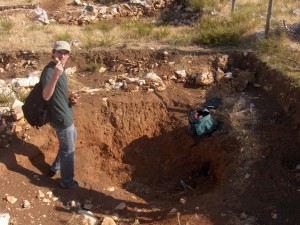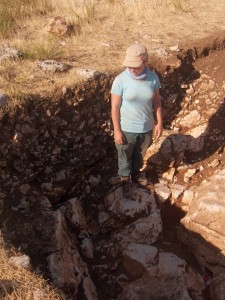A wide range of mineral resources was exploited in the territory of Sagalassos, including ores, clays and natural building stones. Sagalassos is known as a large pottery producing centre, using several local clay resources, exporting its products all over the Roman Empire. Another craft activity was the melting and working of iron. Also, local limestone was exploited to be made into natural building materials, sarcophagi or lime raw material for mortar. The aim of the archaeometrical studies at Sagalassos is therefore to characterise artefacts produced by the different crafts, the identification of the raw materials used and the reconstruction of trade in raw materials or finished product. This year, archaeometrical work focussed on the site of Tepe Düzen.
The plateau of Düzen and the neighbouring Zençirli Tepe (mountain) both consist of beige limestone, overlying ophiolitic mélange (a volcanic rock). In between the two parts, a limestone breccia is present, and the Düzen plateau is bordered by sandstone. However, in the excavation layers at Tepe Düzen and in the virgin soil on top of the limestone and limestone breccia bedrock, many special minerals such as grossular (a garnet), tourmaline and magnetite (an iron ore) are found. These minerals do not occur is the geological substrate as we see it now, but most likely have their origin in a now entirely weathered (and hence disappeared) metamorphic rock. From the stratigraphy of the virgin soil and the cultural deposits, it can be assumed that these heavy minerals were concentrated by their high resistance to weathering and their high density in shallow depressions on the surface of the bedrock. Such deposits, where minerals are concentrated by their weight, are called placer deposits. These were most likely exploited in historical-archaeological times. At Düzen, traces of iron smelting were identified in previous excavation campaigns, and the exploitation of magnetite concentrations in the subsoil likely provides the raw material for this craft, though further analysis will need to confirm this. It is also possible that the grossular minerals were likewise used, in the production of ornamental materials and jewelry.



